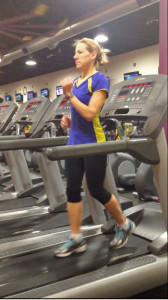 Retro Training: A Helpful Adjunct to Rehab and Fitness
Retro Training: A Helpful Adjunct to Rehab and Fitness
by Michelle Higgins, PTA, CPT
Retro Training is a simple training technique in which a person walks backward on the ground or on a treadmill. Observational experience has led physical therapists to consider the numerous benefits of this activity, particularly for strength training individuals with knee pain, hip pain, ankle dysfunction and even back pain. In fact, Retro Training significantly reduces the joint reaction forces at initial contact1 making for a healthier activity for those with arthritic conditions. Research has demonstrated that patients diagnosed with patellofemoral pain syndrome who participated in Retro Training in addition to traditional therapeutic exercise demonstrated improved function and less pain than control subjects whose intervention did not include retro training.1,2
Consider the implications of walking all day on lower limb strength. Our anterior muscles are called to action much more than our posterior muscles. This repeated concentric (shortening) movement eventually starts to produce damaging stresses, particularly to the patella. Importantly, our true strength is accomplished through the eccentric (lengthening) phase of muscle movement, hence why Retro Training is believed to work so well. The quadriceps muscles must function eccentrically during this activity, gaining better functional strength without joint irritation. The hamstring muscles, which are typically neglected, play an important role in supporting the knee joint. An increased stretch of the hamstring muscles during backward walking; combined with decreased hip extension leads to decreased stress on the hamstring in a lengthened position. This is advantageous for the development of our posterior muscles.
Another benefit of Retro Training is the balance gain related to forced reliance on proprioceptive inputs (orientation/position sense). Rear-facing movement does not allow vision to orient to environmental objects to secure balance. The Vestibular System, which tends to be neglected, must provide orientation to compliment the very limited visual information for balance. “If you don’t use it, you lose it” best describes a tendency to overuse vision and under utilize this most accurate hard-wired orientation system, especially as people age. The Vestibular System is similar to other systems that depreciate if not “worked”. Retro Training accomplishes this goal of stimulating balance by forcing a reliance on the Vestibular System.
I have personally experimented with this activity for many years on the treadmill, and created a series of steps for safe progression. Initially, speed should be slow and the treadmill hand rails should be used. Individuals should start with 10 minutes 2x/wk in order to self-evaluate post activity. Emphasis should be on technique and maintaining a good erect posture. Once comfortable while holding on, the next step would be to remove the hands from support, but keep in mind that this will significantly increase the challenge of the exercise. If comfortable enough to try it, begin to lighten up on your hold of the rails and allow your arms to swing naturally. The next progression would be to increase speed and/or elevation. An advanced progression, increasing the incline should only be attempted when you have reached your max speed for your max desired duration at no incline.
It is important to note that Retro Training may not be right for everyone and should be discussed your physical therapist before beginning a program. If pain is present during exercise, or dizziness occurs with backward movement, please discontinue the activity. Looking forward at a fixed point can help alleviate any motion sensitivity from walking backward.
Watch a video demonstration of Retro Training at https://youtu.be/aMoiUvkR0ck.
1Flynn TW, Soutas-Little,RW. Patellofemoral Joint Compressive Forces in Forward and Backward Running Journal of Orthopaedic & Sports Physical Therapy, 1995, Volume: 21 Issue: 5 Pages: 277-282 doi:10.2519/jospt.1995.21.5.277
2Kedia, S, Saurabh, S. Effect of Retro-Treadmill Ambulation Training in Patellofemoral Pain Patients. Physiotherapy & Occupational Therapy Journal . Apr-Jun2012, Vol. 5 Issue 2, p59-64.
